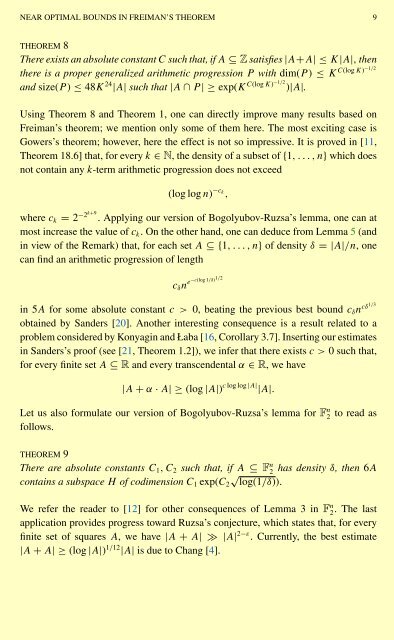NEAR OPTIMAL BOUNDS IN FREIMAN'S THEOREM
NEAR OPTIMAL BOUNDS IN FREIMAN'S THEOREM
NEAR OPTIMAL BOUNDS IN FREIMAN'S THEOREM
You also want an ePaper? Increase the reach of your titles
YUMPU automatically turns print PDFs into web optimized ePapers that Google loves.
<strong>NEAR</strong> <strong>OPTIMAL</strong> <strong>BOUNDS</strong> <strong>IN</strong> FREIMAN’S <strong>THEOREM</strong> 9<br />
<strong>THEOREM</strong> 8<br />
There exists an absolute constant C such that, if A ⊆ Z satisfies |A+A| ≤K|A|, then<br />
C(log K)−1/2<br />
there is a proper generalized arithmetic progression P with dim(P ) ≤ K<br />
and size(P ) ≤ 48K24 C(log K)−1/2<br />
|A| such that |A ∩ P |≥exp(K )|A|.<br />
Using Theorem 8 and Theorem 1, one can directly improve many results based on<br />
Freiman’s theorem; we mention only some of them here. The most exciting case is<br />
Gowers’s theorem; however, here the effect is not so impressive. It is proved in [11,<br />
Theorem 18.6] that, for every k ∈ N, the density of a subset of {1,...,n} which does<br />
not contain any k-term arithmetic progression does not exceed<br />
(log log n) −ck ,<br />
where ck = 2−2k+9. Applying our version of Bogolyubov-Ruzsa’s lemma, one can at<br />
most increase the value of ck. On the other hand, one can deduce from Lemma 5 (and<br />
in view of the Remark) that, for each set A ⊆{1,...,n} of density δ =|A|/n, one<br />
can find an arithmetic progression of length<br />
1/δ)1/2<br />
e−c(log<br />
cδn<br />
in 5A for some absolute constant c>0, beating the previous best bound cδn cδ1/3<br />
obtained by Sanders [20]. Another interesting consequence is a result related to a<br />
problem considered by Konyagin and Łaba [16, Corollary 3.7]. Inserting our estimates<br />
in Sanders’s proof (see [21, Theorem 1.2]), we infer that there exists c>0 such that,<br />
for every finite set A ⊆ R and every transcendental α ∈ R, wehave<br />
|A + α · A| ≥(log |A|) c log log |A| |A|.<br />
Let us also formulate our version of Bogolyubov-Ruzsa’s lemma for F n 2<br />
follows.<br />
<strong>THEOREM</strong> 9<br />
There are absolute constants C1,C2 such that, if A ⊆ Fn 2<br />
to read as<br />
has density δ, then6A<br />
√<br />
contains a subspace H of codimension C1 exp(C2 log(1/δ)).<br />
We refer the reader to [12] for other consequences of Lemma 3 in F n 2 . The last<br />
application provides progress toward Ruzsa’s conjecture, which states that, for every<br />
finite set of squares A, wehave|A + A| ≫|A| 2−ε . Currently, the best estimate<br />
|A + A| ≥(log |A|) 1/12 |A| is due to Chang [4].

















